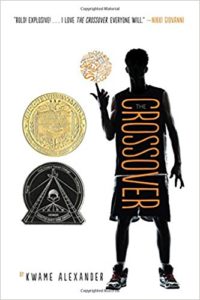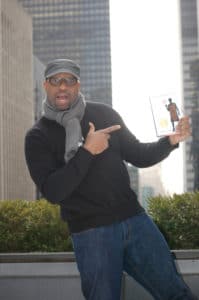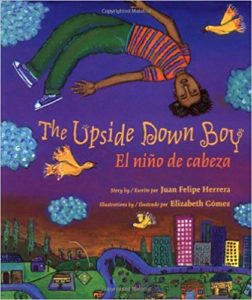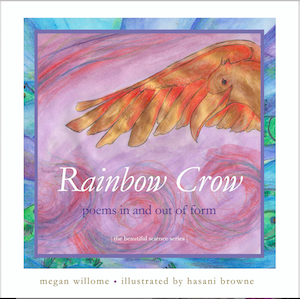I’ve always thought that if you want to get reluctant readers engaged with literature, start with poetry.”
Tis the season … for basketball. When my son played the sport in middle and high school, winter break meant tournaments. The Crossover by Kwame Alexander is a story, told through poems, of twin boys, Josh and Jordan, who play on their eighth-grade team, and about their father, who played professional ball. Christmas is significant in a basketball sort of way. That’s why we’re reading this book in December.
The author, Kwame Alexander, has written 28 books, and this one won the Newbery and the Coretta Scott King awards. He teaches creative writing to K-12 students in his The Write Thing workshops. He says everyone in his family is some type of artist.
Alexander started writing poems at age 12 and wrote one in college for the woman he later married, so perhaps it’s no surprise that this book, which took him five years to write, contains a love story. He wrote The Crossover in verse because he thought poetry was the best medium to capture basketball.
Tweetspeak’s Callie Feyen brought the book to my attention when she wrote about As-In poems for an October poetry prompt. She featured “pul-chri-tu-di-nous,” in which the narrator, Josh, is trying to understand the appeal of the new girl, who only has eyes for his brother.
Here’s a section from a different As-In poem that covers one of the other significant themes in the book: hypertension. Which is interesting, because in my latest Reader, Come Home column, I covered a book about heart disease. (I read The Crossover first.) But the juxtaposition seems fitting. Heart disease is the number one killer in America, and it is unusually prevalent among Black Americans, like the family in this book.
my-o-car-di-al in-farc-tion
As in: The doctor sees me Googling
the symptoms — coughing, sweating,
vomiting, nosebleeds — and he says,
You know we can’t be sure
what causes a myocardial infarction. I say, What about
doughnuts and fried chicken and genetics?

This book faked me out more than once. The clues are strewn deftly, like behind-the-back passes. I’d think I knew where it was going only to realize I’d been faked out. Again.
But if I’d paid better attention to the series of poems scattered along the way, called Basketball Rules, I might have better anticipated Alexander’s next poetic move. The rule poems function like cairns on a wilderness trail — they let us know where we’re going.
Basketball Rule #1
In this game of life
your family is the court
and the ball is your heart.
No matter how how good you are,
no matter how down you get,
always leave
your heart
on the court
When I reread that poem, after completing the story, I realized it is, essentially, the plot. This story is about brothers. It’s about fathers and sons. It’s about middle school. It’s about having two names, one for family and one for the court. And it’s about basketball — the sheer glory of the sport.
Here’s my favorite poem, from early in the book. It captures Josh’s swagger, the essence of his game, and his crossover.
Ode to My Hair
If my hair were a tree
I’d climb it.
I’d kneel down beneath
and enshrine it.
I’d treat it like gold
and then mine it.
Each day before school
I unwind it.
And right before games
I entwine it.
These locks on my head
I designed it.
And one last thing if
you don’t mind it:
That bet you just made?
I DECLINE IT.
– Kwame Alexander
_______________
The next Children’s Book Club will meet Friday, January 11. We’ll read The Upside Down Boy / El Niño de Cabeza by Juan Felipe Herrera, former U.S. Poet Laureate. This picture book, told in Spanish and English, is his memoir.
Photo by Deep Owl, Creative Commons, via Flickr. Post by Megan Willome, author of The Joy of Poetry.
Browse more Children’s Book Club
“Megan Willome has captured the essence of crow in this delightful children’s collection. Not only do the poems introduce the reader to the unusual habits and nature of this bird, but also different forms of poetry as well.”
—Michelle Ortega, poet and children’s speech pathologist
- Perspective: The Two, The Only: Calvin and Hobbes - December 16, 2022
- Children’s Book Club: A Very Haunted Christmas - December 9, 2022
- By Heart: ‘The night is darkening round me’ by Emily Brontë - December 2, 2022




L.L. Barkat says
Very interesting technique you’ve highlighted: the way the writer “faked out” the reader, just as in basketball. So many things to think about as a writer! It’s the story, yes, but often so much more—and this comes back round to influence the story and the reader’s experience of it.
Enjoyed this piece. 🙂
Megan Willome says
So glad you did. The book is a great example of unstuffy, compelling, narrative-driven poetry.
Sharon A Gibbs says
Megan,
I love your observations about the arc of the crossover, the visual of shifting the ball from one hand to the other—and being faked out. Like a skilled dribbler, Kwame does have the moves. But he keeps us in the game.
It took me several pages to warm to the book. So glad I stayed with it! The last poem in the Warm Up, “Basketball Rule #1”, got my attention like a buzzer at the beginning of a game. This poem set me up for the story he dished: one of family and heart, of staying in the game despite all else, and learning “how to rebound on the court. And off.”
The basketball rules hold true for life. Two of my favs:
Basketball Rule #5
When
you stop
playing
your game
you’ve already
lost.
Basketball Rule #8
Sometimes
you have to
lean back
a little
and
fade away
to get
the best
shot.
Kwame’s words bounce and dribble, cross and flip, stutter and strut, and pass and spin. (It was fun to read some of the poems aloud.) He formed his poems in so many interesting ways: lists, questions, text messages, conversations, and those As-In poems. He made small moments large and meaningful.
He faked out this reader, too. Oh, to write like that. ☺
Megan Willome says
Sharon, I love all the basketball imagery you brought into your thoughts about his poetry, because you’re exactly right. The game has a rhythm, and of course, poetry is all about rhythm.
I really like “Basketball Rule #8,” in light of the story. And, well, life.